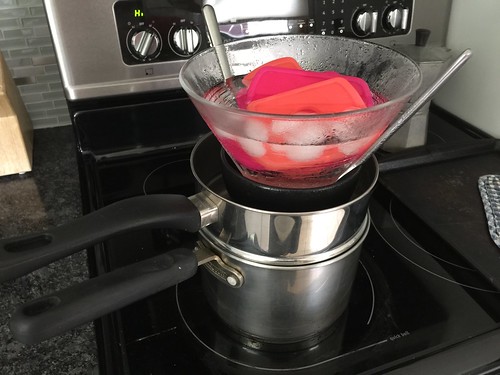Over the weekend, I noticed that the blueberry bushes in the yard were starting to yellow a bit. Yellowing leaves, after a few minutes of Googling, is apparently a symptom of either dryness or insufficient acidity in the soil. I decided to test for the latter first, since it’s the more challenging thing to test. In order to test for acidity, you need a pH meter. pH meters are devices that determine the number of acid ions in a liquid solution, usually through electrical conductivity, and require calibration.
Here’s where I ran into trouble: I didn’t have a calibration solution on hand. I figured I’d just distill some water and use that to calibrate the meter, because distilled water should have a pH of 7, a known pH.
Unfortunately, it turns out that distilled water is extremely receptive to carbon dioxide in the air and thus becomes acidic very quickly – but not at a reliable rate. What I ended up doing was boiling 1000mL distilled water (to remove dissolved gases), then quickly adding 11.9 grams of anhydrous citric acid to it (to give it a known pH of 4), then sealing it in an airtight container until it returned to roughly room temperature.
In the end, that procedure gives as close to a known pH for testing as you can probably get at home without buying even more laboratory equipment. From there, I was able to test the soil around my blueberry bushes and ascertain that the pH of the soil was far too basic for them to be comfortable, around 8.5 when it should be 5.5-6.0. Why? I re-use grey water from the bathtub, and any water that has soap in it is going to be basic with a fairly high pH. The remedy is simple: just add acid. Adding citric acid or vinegar in a small quantity quickly turns bath water acidic, which makes it perfect for blueberry bushes.
What in the world does any of this have to do with marketing? As you just read, effective measurement begins with calibration, with knowing what the situation is in order to take action. If your calibration is wrong, all your measurement will be wrong.
An obvious incorrect calibration would be something like not having Google Analytics tracking tags on all your web pages. If you’re only tracking some pages but asking for full site data, your instrumentation is giving you wrong information. Calibration in that case – ensuring that you’re measuring correctly – involves validating you set up Google Analytics correctly.
A less obvious calibration error would be incorporating something like an “industry standard” metric in your reporting, such as the “industry standard” email open rate or retweet rate. These industry standard numbers are based off of aggregated, highly generic data sets (sometimes of unknown provenance) and thus you have no idea how they were set. Basing your measurement off them assumes that the provider of the “standard” knew what they were doing.
Even if the “standard” was correct, it would still be less relevant to your specific company; the example I often give in public talks is that your local neighborhood credit union and a Wall Street mega-bank are both in the same industry, financial services. To assume they will have similar marketing performance metrics is ludicrous, but that’s what you do when you use a statistic like “industry standard in financial services”.
Before you embark on marketing analytics and measurement, ensure that you’re calibrated correctly and you know the quality of your measurement tools and methodology. Otherwise, you run the risk of making very bad decisions from incorrect data.
Finally, it was pointed out to me on Facebook that household distilled white vinegar has a known pH of 2.4, and would have been a lot simpler to calibrate from, rather than hacking together what I did. Let this be the final lesson in calibration: the more knowledge you have up front, the easier your calibration will be.
You might also enjoy:
- You Ask, I Answer: Retrieval Augmented Generation for Tax Law?
- You Ask, I Answer: Legality of Works in Custom GPTs?
- You Ask, I Answer: Retrieval Augmented Generation vs Fine-Tuning?
- Almost Timely News, January 14, 2024: The Future of Generative AI is Open
- Almost Timely News: Recipes vs. Principles in Generative AI (2024-03-03)
Want to read more like this from Christopher Penn? Get updates here:
 Take my Generative AI for Marketers course! |



Leave a Reply